Cancer Statistics By Types, Treatment And Facts (2025)

Updated · Jun 27, 2025

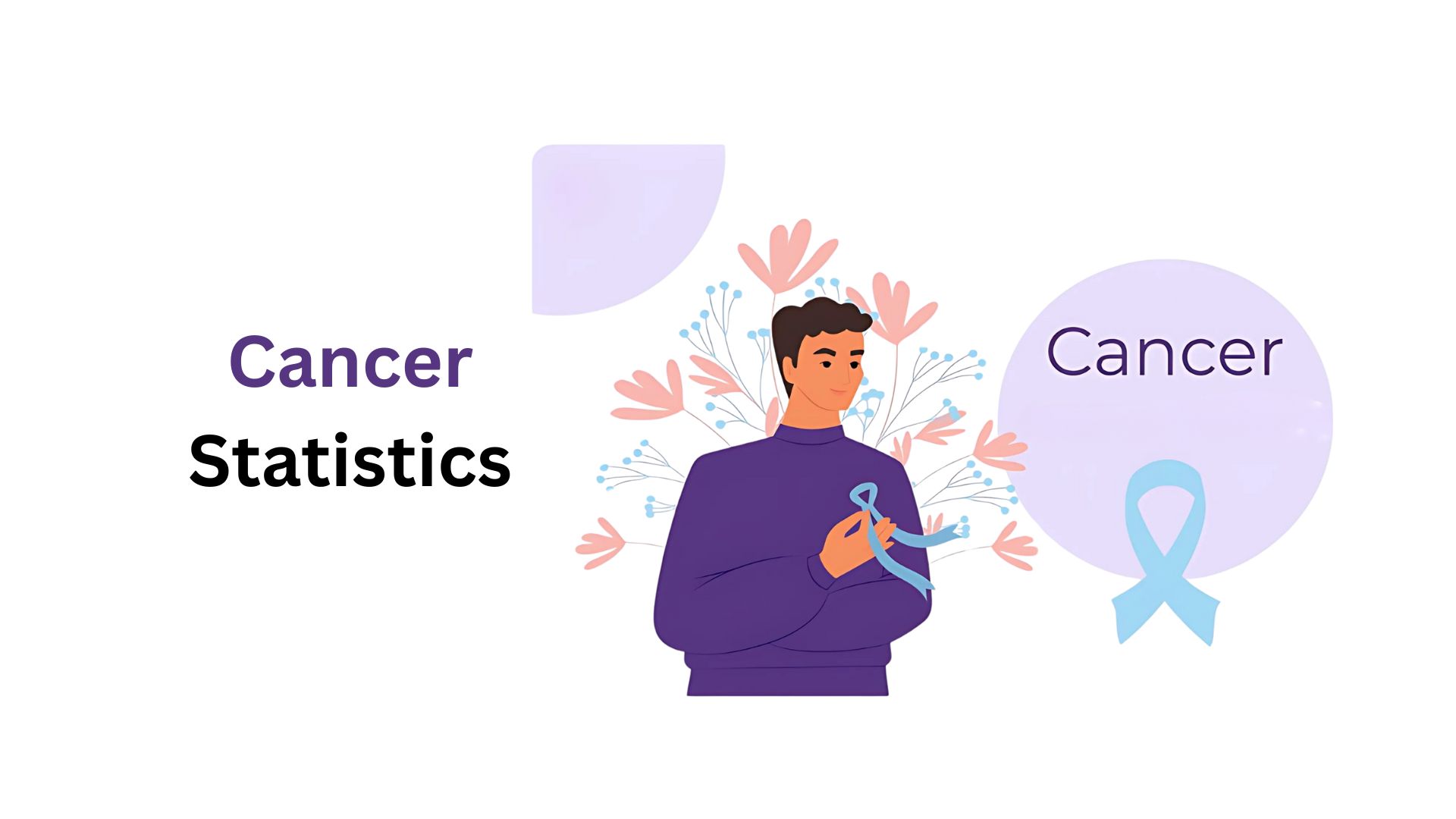
WHAT WE HAVE ON THIS PAGE
- Introduction
- Editor’s Choice
- General Cancer Statistics
- Types Of Cancer Statistics
- Advancement Statistics In Cancer Treatment
- Estimated New Cancer Cases Statistics by States, 2024
- Estimated Cancer Death Cases Statistics By States, 2024
- Cancer Statistics By Gender
- Cancer Statistics By Age Group, 2024
- Cancer Risk Factor Statistics 2024
- Cancer Statistics By Prevention And Early Detection
- Challenges And Opportunities Of Cancer
- Conclusion
Introduction
Cancer Statistics: Cancer continues to be a major global health challenge, with significant increases in both incidence and mortality. In 2022, there were an estimated 20 million new cancer cases and 9.7 million cancer-related deaths worldwide. The most common cancers included lung, breast, colorectal, prostate, and stomach cancers. The global cancer burden is projected to rise substantially, with estimates suggesting 35.3 million new cases and 18.5 million cancer-related deaths by 2050.
This increase is attributed to factors such as population growth, aging, and exposure to risk factors like tobacco use, obesity, and environmental pollutants. The economic impact of cancer is also profound, with direct medical costs in the United States alone reaching nearly $209 billion in 2020.
These statistics underscore the urgent need for enhanced prevention, early detection, and treatment strategies to address the growing cancer burden globally. The information is presented from a market researcher’s point of view, incorporating the latest data and trends.
Editor’s Choice
- Cancer Statistics show that in 2024, approximately 20 million new cancer cases are expected worldwide, reflecting a 5% increase from 2023.
- In the same year, more than 10 million deaths are anticipated globally due to cancer, with lung cancer being the deadliest, causing around 1.8 million deaths.
- The United States of America will see 1.9 million new cancer diagnoses.
- Global cancer-related costs, including direct medical expenses and lost productivity, are projected to exceed USD 1.2 trillion by the end of 2024.
- Around 30% of cancer patients will receive immunotherapy, a treatment method expected to generate USD 160 billion in global revenue.
- From the very beginning, breast cancer has remained the most common cancer among women globally, resulting in 2.5 million new cases.
- Cancer Statistics further states that lung cancer continues to be the most diagnosed and deadliest cancer, with 2.3 million new cases and an 80% mortality rate within five years.
- The Asia-Pacific region, particularly China and India, will account for nearly 40% of global cancer cases, with an estimated 8 million new diagnoses.
- By 2024, 70% of girls globally are expected to receive the HPV vaccine, significantly reducing future cervical cancer cases.
- Global funding for cancer research will reach USD 50 billion, with the U.S. and Europe leading the efforts.
You May Also Like To Read
- Mental Health Statistics
- AI in Healthcare Statistics
- Abortion Statistics
- Vegan Statistics
- Fitness Industry Statistics
- Color Psychology Statistics
- Fitbit Statistics
- Health and Wellness Industry Statistics
- Phobia Statistics
- Sleep Statistics
- Depression Statistics
- Social Anxiety Disorder Statistics
- Vitamin and Supplements Industry Statistics
- Breast Cancer Statistics
- Weight Loss Statistics
General Cancer Statistics
- As of 2024, cancer continues to be a major global health issue, with around 20 million new cases diagnosed each year, representing an increase of 5% from the previous year.
- To date, the most common types of cancer include Lung, Breast, colorectal, and prostate cancer, which collectively account for nearly 50% of all cases worldwide.
- The global cancer mortality rate is also a significant concern, resulting in over 10 million deaths expected by this year’s end.
- Almost 40% of cancer cases are considered curable by changing lifestyle, such as quitting smoking, maintaining a healthy diet, and exercising regularly.
- Cancer Statistics also show that in 2024, cancer is a major cause of death worldwide, responsible for approximately 1 in 6 deaths and impacting nearly every household.
- In the U.S., approximately 611,720 people are expected to die because of cancer, which represents around 1,680 deaths per day.
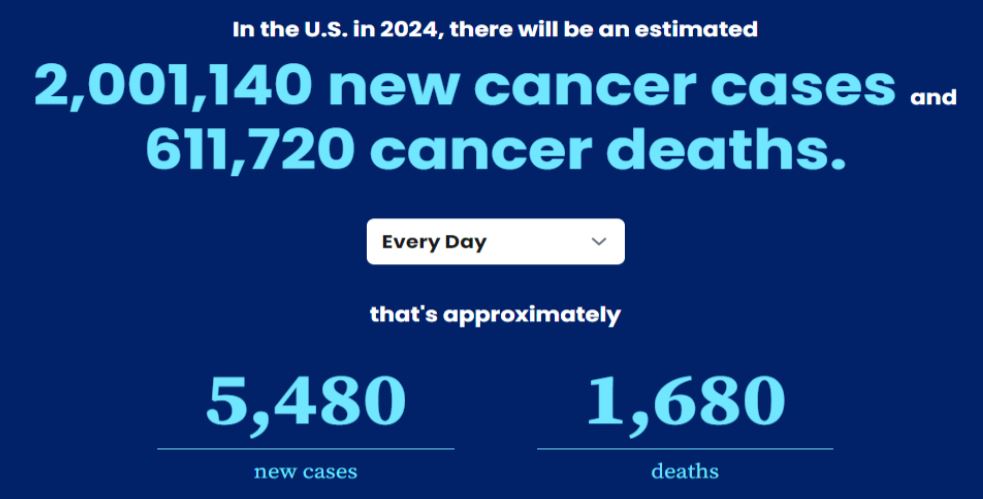
(Source: cancerstatisticscenter.cancer.org)
Types Of Cancer Statistics
- Lung cancer is termed the most commonly diagnosed cancer as of today, with approximately 2.3 million new cases expected globally in 2024.
- Annually, the highest mortality rate accounted for 1.8 million deaths.
- On the other hand, in 2024, the 5-year survival rate for lung cancer is less than 20% due to late-stage diagnosis.
- Smoking remains the leading cause, though, in recent years, cancer cases among non-smokers are increasing.
Furthermore, the table below analyses other types of cancer cases, including incidence and mortality rates.
| Cancer Types | Incidence (Expected new cases) | Mortality Rate | Key Factors |
| Breast Cancer | 2.5 million | Despite high incidence rates, advancements in early detection and treatment have improved the 5-year survival rate to 90% in developed countries. | Genetic predisposition, hormone replacement therapy, and lifestyle. |
| Colorectal Cancer | 1.9 million | It will cause around 935,000 deaths by 2024. | Diets high in red and processed meats, low physical activity, and obesity. |
| Prostate Cancer | 1.4 million | The 5-year survival rate for prostate cancer is high at 98% | Age, family history, and ethnicity (higher rates in African American men) |
| Stomach Cancer | around 1 million | It is responsible for approximately 770,000 deaths annually, with a 5-year survival rate of about 32% due to late diagnosis. | Helicobacter pylori infection, diets high in salty and smoked foods, and smoking. |
| Liver Cancer | 900,000 | Eight hundred thirty thousand deaths with a 5-year survival rate of only 18%. | Hepatitis B and C infections, heavy alcohol consumption, and obesity contribute to liver cancer risk. |
| Cervical Cancer | 600,000 women | 300,000 deaths each year | Human papillomavirus (HPV) infection is the basic reason, and vaccination programs are key to prevention. |
| Pancreatic Cancer | 496,000 | This cancer has one of the lowest 5-year survival rates at around 10%, causing approximately 466,000 deaths in 2024. | Smoking, chronic pancreatitis, and family history. |
| Ovarian Cancer | 313,000 | 207,000 deaths, and 45% of 5-year survival rate. | Age, genetics (BRCA mutations), and reproductive history play crucial roles in risk. |
| Esophageal Cancer | 570,000 | 510,000 deaths and a 5-year survival rate of only 20%. | Tobacco use, alcohol consumption, and gastroesophageal reflux disease (GERD). |
Advancement Statistics In Cancer Treatment
- Immunotherapy:
– Cancer Statistics also elaborates that nearly 30% of cancer patients will receive some form of immunotherapy by 2024.
– Meanwhile, the global market for immunotherapy drugs will reach around USD 160 billion by the end of the year. - Targeted Therapy Growth: These therapies are focused on specific molecules involved in cancer growth and are expected to generate USD 120 billion in global revenue.
- Precision Medicine: The treatment based on an individual’s genetic profile is utilized by over 50% of cancer patients in developed countries.
- CAR-T Cell Therapy: Chimeric Antigen Receptor T-cell (CAR-T) therapy is a form of immunotherapy, and the market is supposed to reach USD 8 billion.
- AI in Oncology: By 2024, AI-driven oncology tools will improve diagnosis accuracy by 20%, leading to more personalized and effective treatment plans.

(Source: cancerstatisticscenter.cancer.org)

Estimated New Cancer Cases Statistics by States, 2024

(Source: cancer.org)
| States | Female Breast | Colon & rectum | Leukaemia | Lung & bronchus | Melanoma of the skin | Non-Hodgkin lymphoma | Prostate | Urinary bladder | Uterine cervix | Uterine corpus |
| United States | 310,720 | 152,810 | 62,770 | 234,580 | 100,640 | 80,620 | 299,010 | 83,190 | 13,820 | 67,880 |
| Washington | 7450 | 3140 | 1480 | 4780 | 2650 | 1890 | 6350 | 1910 | 290 | 1,490 |
| California | 32,660 | 16,170 | 5700 | 16,920 | 10,570 | 8320 | 26,350 | 7330 | 1560 | 7140 |
| Alabama | 4800 | 2570 | 780 | 4230 | 1400 | 1000 | 5180 | 1190 | 230 | 840 |
| Colorado | 5150 | 2130 | 940 | 2660 | 1990 | 1180 | 4490 | 1200 | 190 | 870 |
| New York | 19,160 | 8780 | 3860 | 14,200 | 4050 | 5010 | 20,630 | 5330 | 840 | 4610 |
| Texas | 23,290 | 12,260 | 4940 | 14,430 | 5340 | 5760 | 20790 | 4720 | 1450 | 4790 |
| Virginia | 8180 | 3640 | 1320 | 5980 | 2480 | 1920 | 9200 | 1930 | 310 | 1690 |
| Pennsylvania | 13,370 | 6550 | 2710 | 11,200 | 3870 | 3610 | 13,010 | 4290 | 510 | 3460 |
| New Jersey | 8880 | 4240 | 1940 | 5600 | 2330 | 2490 | 9860 | 2540 | 370 | 2230 |
| Utah | 2200 | 950 | 490 | 810 | 1490 | 600 | 2,380 | 510 | 100 | 510 |
| Massachusetts | 7150 | 2790 | 1300 | 5620 | 1530 | 1790 | 6,420 | 1,950 | 210 | 1600 |
| Michigan | 9410 | 4640 | 1880 | 8690 | 3080 | 2570 | 10,480 | 2,870 | 390 | 2470 |
| Ohio | 11,500 | 5890 | 2050 | 10,390 | 4290 | 2880 | 10,670 | 3,380 | 510 | 2,680 |
| Florida | 23,160 | 11,920 | 6420 | 18,580 | 9880 | 7940 | 24,090 | 7520 | 1,170 | 4,860 |
Estimated Cancer Death Cases Statistics By States, 2024
| States | Brain & other nervous system | Female Breast | Colon & rectum | Leukaemia | Liver & intrahepatic bile duct | Lung & bronchus | Non-Hodgkin lymphoma | Ovary | Pancreas | Prostate |
| United States | 18,760 | 42,250 | 53,010 | 23,670 | 29,840 | 125,070 | 20,140 | 12,740 | 51,750 | 35,250 |
| Washington | 480 | 960 | 1070 | 520 | 720 | 2580 | 490 | 320 | 1240 | 880 |
| California | 2,150 | 4,570 | 5500 | 2,330 | 3,580 | 9320 | 2,160 | 1410 | 5120 | 4200 |
| Alabama | 310 | 710 | 900 | 360 | 510 | 2550 | 280 | 200 | 850 | 560 |
| Colorado | 300 | 700 | 820 | 370 | 370 | 1290 | 280 | 200 | 730 | 630 |
| New York | 940 | 2080 | 2700 | 1,050 | 1260 | 6100 | 1,000 | 780 | 3,010 | 1630 |
| Texas | 1,330 | 3,280 | 4410 | 1,630 | 2960 | 8050 | 1430 | 960 | 3600 | 2360 |
| Virginia | 460 | 1160 | 1390 | 610 | 730 | 3380 | 500 | 340 | 1,380 | 970 |
| Pennsylvania | 820 | 1820 | 2230 | 1,070 | 1310 | 5570 | 930 | 570 | 2400 | 1500 |
| New Jersey | 500 | 1170 | 1330 | 630 | 620 | 2700 | 520 | 340 | 1440 | 740 |
| Utah | 160 | 330 | 320 | 190 | 190 | 460 | 140 | 110 | 310 | 330 |
| Massachusetts | 440 | 730 | 860 | 480 | 600 | 2490 | 380 | 290 | 1140 | 700 |
| Michigan | 610 | 1350 | 1880 | 830 | 1000 | 4920 | 760 | 440 | 1900 | 1130 |
| Ohio | 700 | 1630 | 2070 | 960 | 1000 | 5670 | 810 | 480 | 1,910 | 1,250 |
| Florida | 1,460 | 3,160 | 3980 | 2,020 | 2180 | 10,230 | 1,560 | 1050 | 4,070 | 2,800 |
Cancer Statistics By Gender
Developing Cancer
 (Reference: cancerstatisticscenter.cancer.org)
(Reference: cancerstatisticscenter.cancer.org)
- The above graph explains that 41.6% of cancers will develop in males in 2024, compared to 39.6% in females, whereas the overall cancer-developing share is 40.5%.
- The top five types of developing cancer shared by gender are Breast (female: 13%), Prostate (male: 12.9%), Lung and bronchus (male: 6.3%, female: 5.9%, and total: 6.1%), Colorectum (male: 4.3%, female: 3.9%, and total: 6.1%), and Melanoma of the skin (male: 3.6%, female: 2.5%, and total: 3.0%).
Dying Of Cancer
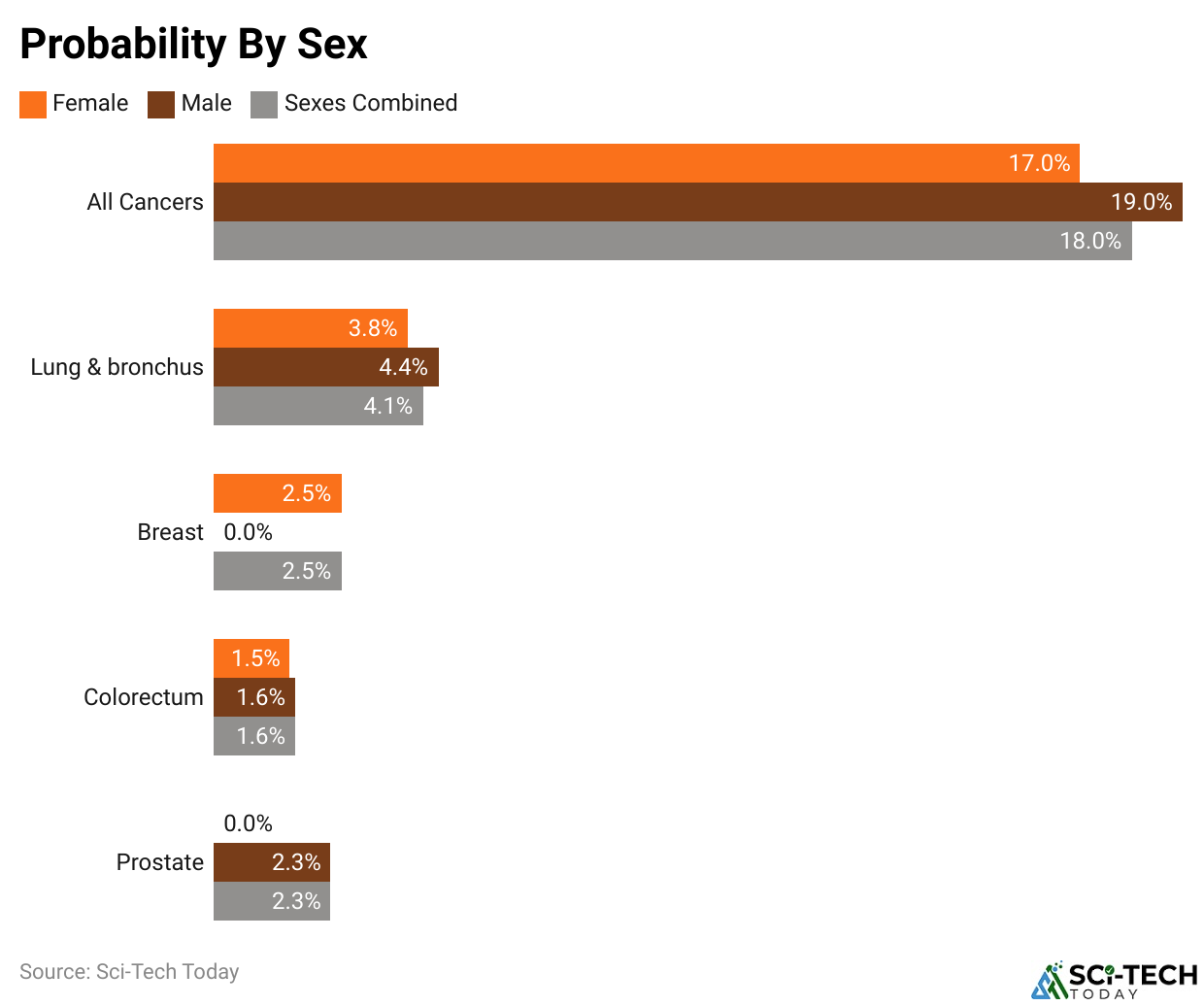
(Reference: cancerstatisticscenter.cancer.org)
- A report published by the American Cancer Society further detailed that the death rate of cancer in 2024 remained highest in males at 19%, followed by females (17%) and sex combined (18%).
- Similarly, Cancer Statistics also ensure the top dying cancer type by gender includes Lung and bronchus (male: 4.4%, female: 3.8%, and total: 4.1%), Breast (female: 2.5%), Colorectum (male: 1.6%, female: 1.5%, and total: 1.6%), Prostate (male: 2.3%), and Liver and intrahepatic (male: 1%, female: 0.5%, and total: 0.8%).
Cancer Statistics By Age Group, 2024
Developing Cancer
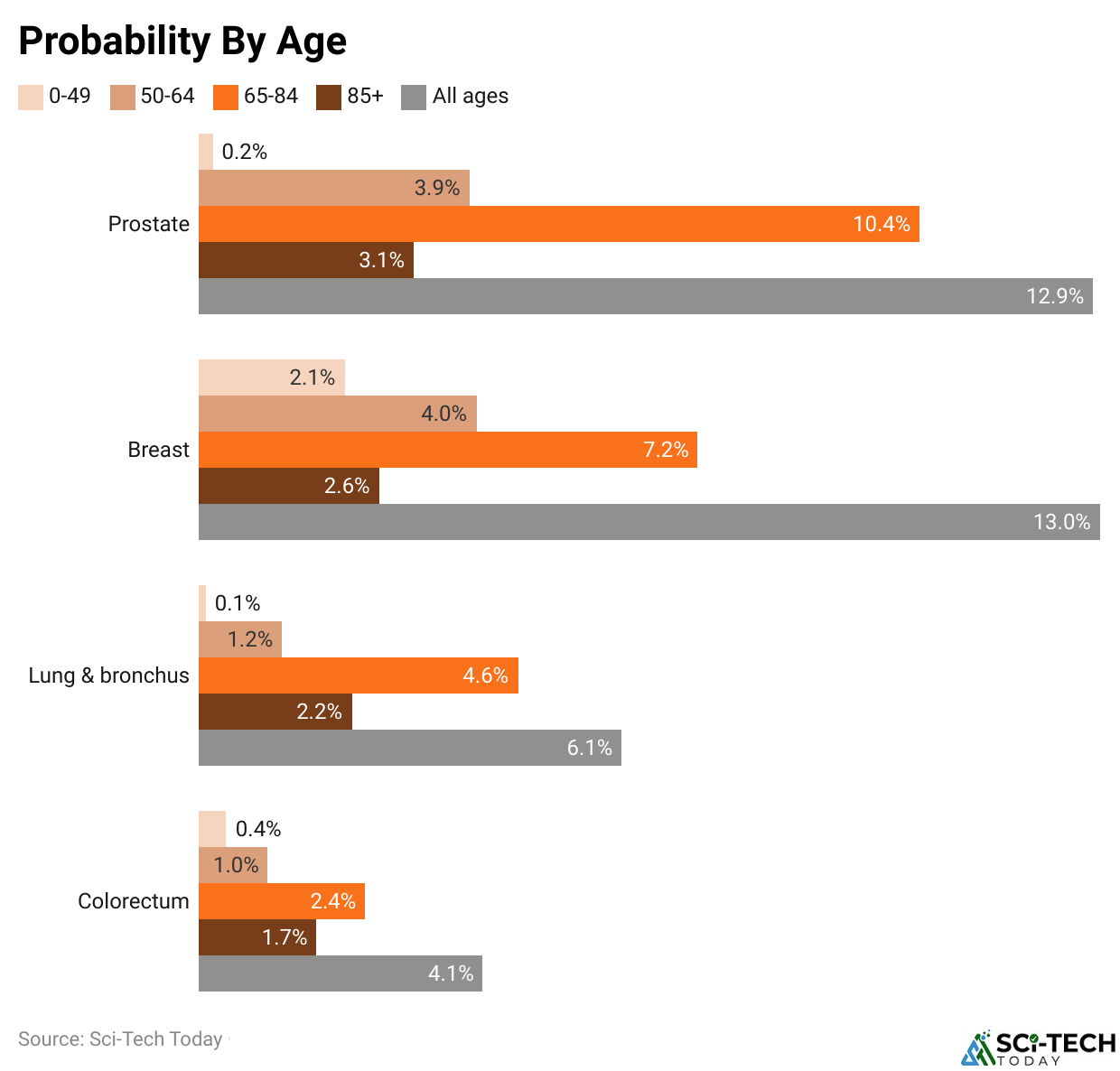
(Reference: cancerstatisticscenter.cancer.org)
| Cancer Type | 0-49 years | 50-64 years | 65-84 years | 85 years+ | All Ages |
| Prostate | 0.2% | 3.9% | 10.4% | 3.1% | 12.9% |
| Breast | 2.1% | 4% | 7.2% | 2.6% | 13% |
| Lung and bronchus | 0.1% | 4% | 7.2% | 2.6% | 13% |
| Colorectum | 0.4% | 1% | 2.4% | 1.7% | 4.1% |
| Melanoma of the skin | 0.5% | 0.8% | 1.7% | 0.9% | 3% |
Dying Of Cancer
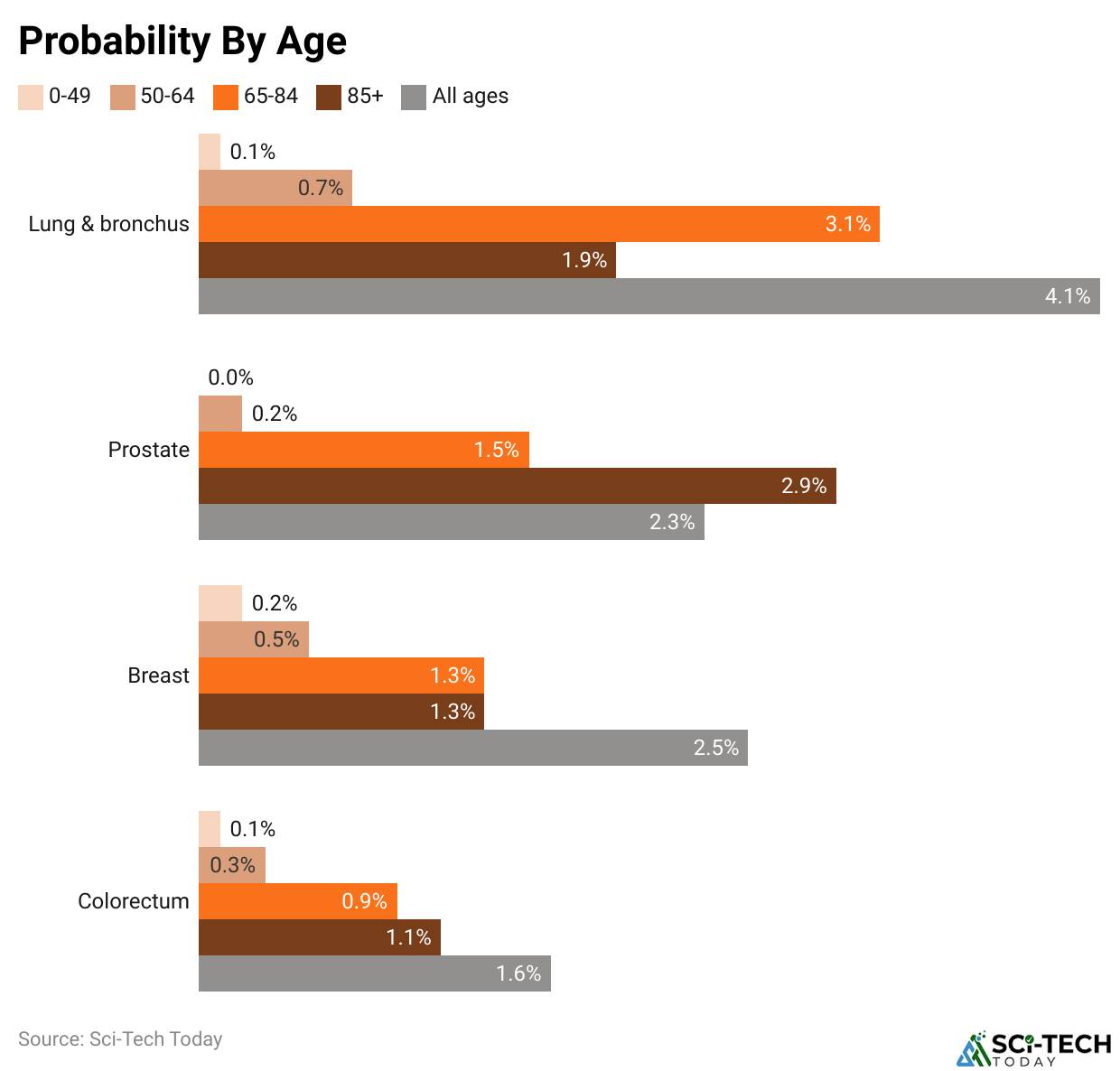
(Reference: cancerstatisticscenter.cancer.org)
| Cancer Type | 0-49 years | 50-64 years | 65-84 years | 85 years+ | All Ages |
| Lung and bronchus | 0.1% | 0.7% | 3.1% | 1.9% | 4.1% |
| Prostate | 0.0% | 0.2% | 1.5% | 2.9% | 2.3% |
| Breast | 0.2% | 0.5% | 1.3% | 1.3% | 2.5% |
| Colorectum | 0.1% | 0.3% | 0.9% | 1.1% | 1.6% |
| Pancreas | 0.0% | 0.2% | 1.0% | 0.7% | 1.4% |
Cancer Risk Factor Statistics 2024
Tobacco Use
- Cancer Statistics further show that tobacco use remains the main preventable cause of cancer, responsible for approximately 22% of cancer deaths globally in 2024.
- Annually, over 1 billion people globally use tobacco, with about 8 million tobacco-related deaths and 1.8 million suffering from lung cancer alone.
Alcohol Consumption
- In the same duration, alcohol use is responsible for about 5% of global cancer cases (740,000 cases) and 4% of cancer deaths.
Obesity And Overweight
- Excess body weight is associated with 7-8% of all cancer cases, resulting in 600,000 cases.
On the other hand, other key risk factors, by share of cancer cases in 2024, are a lack of physical activity (3-4%), unhealthy diet (5-10%), infections (15%), environmental and occupational exposures (5-10%), ultraviolet radiation (90% of non-melanoma skin cancers and 86% of melanomas), genetic factors (5-10%), and hormonal factors (5-7%).
You May Also Like To Read
- Alcoholism Statistics
- Energy Drink Statistics
- Food Truck Statistics
- Tea Statistics
- Wine Industry Statistics
- Yoga Industry Growth Statistics
Cancer Statistics By Prevention And Early Detection
- Around 40% of cancer cases are considered curable by changing lifestyle, such as quitting smoking, maintaining a healthy diet, and exercising regularly.
- In the U.S., mammography screening has led to a 30% reduction in breast cancer deaths since its implementation.
- Cancer Statistics also show that 70% of girls worldwide will receive the HPV vaccine by the age of 15, which will significantly decrease the incidence rate of cervical cancer in the coming decades.
By Economic Impacts
- As of 2024, the United States of America has faced the highest economic burden as cancer-related costs will reach around USD 250 billion.
- This represents USD 180 billion in direct medical costs and USD 70 billion in lost productivity.
- Cancer Statistics further elaborates that the economic impact of cancer will be up to USD 200 billion in Europe, followed by Asia-Pacific (USD 150 billion).
Challenges And Opportunities Of Cancer
- In 2024, only 30% of low-income countries will have comprehensive cancer treatment facilities, compared to 90% of high-income countries.
- Many patients face financial hardship due to the expense of drugs, therapies, and hospital stays. In the U.S., 25% of cancer patients report struggling to afford treatment.
- As mentioned in Cancer Statistics, the global funding for cancer research will reach USD 50 billion, with the U.S. and Europe leading in research efforts.
Conclusion
In 2024, cancer remains a major global health challenge, with millions of new cases and deaths occurring annually. The burden of cancer is influenced by a variety of risk factors, including lifestyle choices such as tobacco use, alcohol consumption, poor diet, and physical inactivity, as well as environmental exposures and genetic predispositions.
This Cancer Statistics article includes current data and trends from different insights that will approach tackling cancer, one that combines medical advancements with public health efforts to reduce risk factors and promote early detection. By continuing to invest in research and public health, the global community can work towards reducing the incidence rate and impact of cancer in the coming year.
FAQ.
Prevention and early detection are very important, as 40% of cancer cases can be avoided by making healthier lifestyle choices.
Technology is important. AI makes cancer diagnosis 20% more accurate, and precision medicine helps create treatments based on a person’s genetic profile. This approach benefits over 50% of cancer patients in developed countries.
Better treatments and prevention will continue to improve the fight against cancer. However, challenges like access to care and the high cost of treatment must be solved to ensure that everyone benefits equally worldwide.

Barry is a technology enthusiast with a passion for in-depth research on various technological topics. He meticulously gathers comprehensive statistics and facts to assist users. Barry's primary interest lies in understanding the intricacies of software and creating content that highlights its value. When not evaluating applications or programs, Barry enjoys experimenting with new healthy recipes, practicing yoga, meditating, or taking nature walks with his child.









